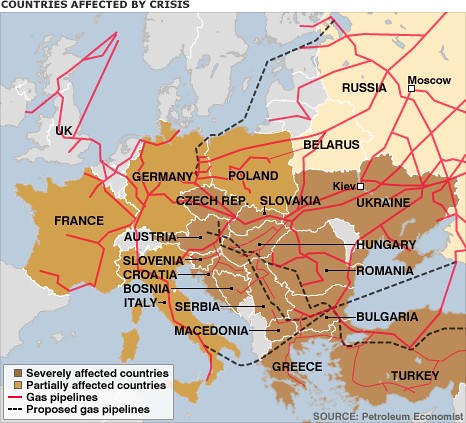
Map of European natural gas pipelines. Credits: BBC, Petroleum Economist.
The Ukraine-Russia natural gas price dispute is still not settled. Ukraine warns that European consumers might see gas shortages in the coming days if the row is not resolved.
Essentially, Gazprom, the Russian gas monopoly wants to charge Ukraine 450 $/1000 m3 (MCM) of gas, a 150% increase from the existing rate of 179 $/1000 MCM. Because 40% of the gas to EU nations passes through Ukraine, a shut-off of Russian gas to Ukraine affects the downstream consumers. The figure is a map of proposed and existing natural gas pipelines and liquefied natural gas (LNG) storage terminals in-and-around Europe. Although Russia claims that part of the gas passing through Ukraine could be diverted via Belarus, consumers in Hungary, Poland Romania and Bulgaria have reported drops in natural gas supply. Here is a somewhat dated presentation describing the natural gas supply and demand outlook for EU-30 nations. According to this, net EU natural gas imports will grow to 670 billion cubic meters (BCM) of natural gas by 2030, accounting for 70% of the natural gas suppply. Of this, Russia is projected to supply 220 BCM (one-third of natural gas imports) by 2030. From this presentation, it is apparent that Russia has one of the the lowest costs for supplying natural gas on a $/MMBTU basis. The BBC has an interesting article on regional geopolitics that might play a role in resolving this issue.
What other options do European countries have in the long-term?
Poland has 24400 million short tons (Mmst) of coal, and is a big regional coal producer. Coal-to-gas technologies could play a significantminor role in displacing Russian natural gas in the long-term. If we assume that 1 short ton of coal produces 20 MMBTU, of which 30% is recoverable as natural gas equivalent heat, the entire Polish coal resource potential is ~4446 BCM in natural gas equivalents, much higher than the 40 BCM/year natural gas consumption in the Visegrad region. On the other hand, with additional European CO2 regulations, investment in technologies with low-carbon emissions(nuclear, wind, biomass) are projected to increase. However, it is not clear if these would displace a significant portion of the EU natural gas demand.
Conclusion: In the short-term, alternatives for relatively clean Russian natural gas might be difficult to find. European coal has a role to play in displacing some portion of Russian natural gas imports, but the long-term EU energy policy needs to address this issue in the context of geopolitics, GHG emissions, carbon trading frameworks and energy security.
See also: Russian Roulette: Energy geopolitics in the Russia-Ukraine gas row II
Essentially, Gazprom, the Russian gas monopoly wants to charge Ukraine 450 $/1000 m3 (MCM) of gas, a 150% increase from the existing rate of 179 $/1000 MCM. Because 40% of the gas to EU nations passes through Ukraine, a shut-off of Russian gas to Ukraine affects the downstream consumers. The figure is a map of proposed and existing natural gas pipelines and liquefied natural gas (LNG) storage terminals in-and-around Europe. Although Russia claims that part of the gas passing through Ukraine could be diverted via Belarus, consumers in Hungary, Poland Romania and Bulgaria have reported drops in natural gas supply. Here is a somewhat dated presentation describing the natural gas supply and demand outlook for EU-30 nations. According to this, net EU natural gas imports will grow to 670 billion cubic meters (BCM) of natural gas by 2030, accounting for 70% of the natural gas suppply. Of this, Russia is projected to supply 220 BCM (one-third of natural gas imports) by 2030. From this presentation, it is apparent that Russia has one of the the lowest costs for supplying natural gas on a $/MMBTU basis. The BBC has an interesting article on regional geopolitics that might play a role in resolving this issue.
What other options do European countries have in the long-term?
Poland has 24400 million short tons (Mmst) of coal, and is a big regional coal producer. Coal-to-gas technologies could play a significant
Conclusion: In the short-term, alternatives for relatively clean Russian natural gas might be difficult to find. European coal has a role to play in displacing some portion of Russian natural gas imports, but the long-term EU energy policy needs to address this issue in the context of geopolitics, GHG emissions, carbon trading frameworks and energy security.
See also: Russian Roulette: Energy geopolitics in the Russia-Ukraine gas row II



3 comments:
Media chatter now has it that the gas is only a lever to force the Ukraine to sell the pipelines to Russia. In a way this is a relief in that the cards go on the table. While we wait for the end game, some light reading in thehiawathatriad.org, triadexp.info, and triadblog.info/blog might be worth while.
Great message! The key, in my view, is learning how to, discovering what and where, figuring out your own internal switch patterns and then generating enthusiasm as the first task of the day.
Post a Comment